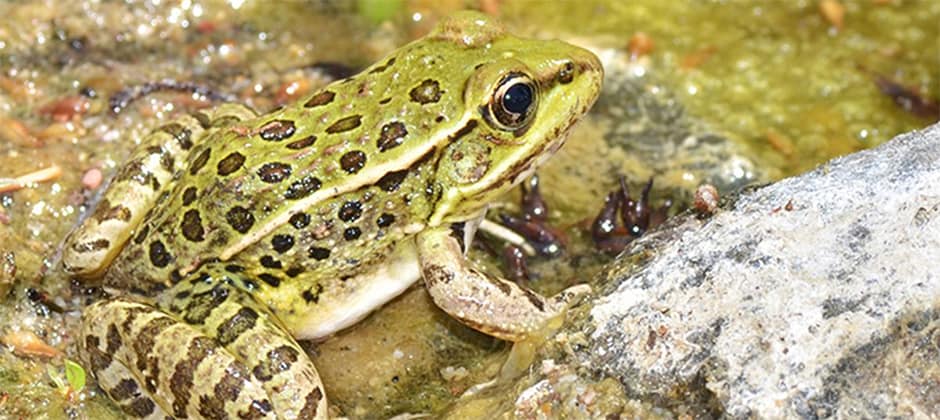Share this article
Immune response to chytrid may kill frogs
People usually think of immune responses as helping bodies recover from diseases. But recent research showed the opposite for at least one frog species facing a deadly amphibian fungus.
Lowland leopard frogs (Rana yavapaiensis) infected with the Batrachochytrium dendrobatidis (Bd) fungus are more likely to die from the disease it causes, chytridiomycosis, if they have a higher immune response to it.
“We definitely made the assumption going into this study that generating stronger immune responses would lead the frogs to survive. Instead, we found the complete opposite pattern,” said Anna Savage, an associate biology professor at the University of Central Florida, who led the study published in Molecular Ecology this month.
Savage had already looked at gene responses to chytrid fungus in lowland leopard frogs as part of her PhD research. She found that certain immune system genes in the frogs were linked to resistance to the fungus that causes chytrid. “But this association doesn’t tell us anything specific about immune function,” she said.
New technological developments in DNA sequencing allowed her to look at entire sets of genes expressed at a given time, rather than looking at one gene at a time. Savage and her colleagues collected frog eggs in the field in Arizona and raised them into frogs in the Smithsonian’s National Zoo. They infected some with the fungus and tested the frogs’ spleens — the main organ in their immune system — as the infections progressed and took note of gene expression patterns, particularly for genes involved in generating immune responses. Then they grouped them as sick, healthy or not infected.
“When we looked at those immune responses, this is where the big shocker happened,” Savage said. Frogs whose immune systems were working overtime were dying more from the fungal disease. The ones that survived had actually decreased their immune expression, she said. “It was active reduction below the uninfected control frogs, not just less of a response.”
Mortality from an immune response isn’t uncommon. Among humans, scientists believe COVID-19 can trigger an over-activation of the immune system, causing people to develop symptoms from the cytokine storm that results. “The immune system is extremely complex,” she said. “Until you test it in a specific context, you don’t know the exact function of any particular gene.”
There are a few possible reason for lowland leopard frogs dying from high immune system activation, Savage said. Bd itself has immunosuppressive properties, and increased immune activation more of the B-cells and T-cells that are the target of that immunosuppression, she said. “Generating a strong memory immune response may be a wasted resource,” she said. As a result, the frogs’ bodies may be expending energy to produce cells that will simply be destroyed.
Savage also said that when they related the immune response back to genetic characterizations, there did seem to be MHC alleles that were only expressed in the frogs that were surviving and reducing their immune response, suggesting that these genes do play an important role in determining the difference between surviving or dying.
Savage is now working on publishing research based on similar gene expression analysis of frogs studied in their natural habitats in Arizona. Because this is not a controlled experiment, these frogs show a wide range of gene expression patterns. but Savage said she has preliminarily found some consistent immune gene expression differences in the frogs with natural Bd infections compared to those without the fungus. She also plans to use CRISPR, a genome editing tool, to learn more about how essential the MHC genes she has been studying are for generating immune responses against Bd.
And this is just one species, she noted. Others may show different immunity variations. “Amphibian disease in general fundamentally requires better knowledge of the host immune system,” she said. That could help researchers determine if an immunization strategy could help protect the frogs.
In the meantime, she said, “the number one thing we can do for mitigation with any conservation issues — including disease — is to protect populations, increase their habitat to allow population growth, reduce pollution — all of those fundamental things.”
Header Image: Lowland leopard frogs that had higher immune responses to chytrid fungus had more incidents of death. Credit: Veronica Urgiles, University of Central Florida Department of Biology








